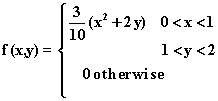
45-733 PROBABILITY AND STATISTICS I 1998 Midterm Examination Answers
Probability and Statistics
Name__________________________
Spring 1998 Flex-Mode and Flex-Time 45-733
Midterm
Keith Poole
(10 Points)
1. Suppose we have the continuous probability distribution
f(x) = 
{ 0 x <= 1
{
F(x) = { (9/8)[1 - 1/x**2] 1 < x < 3
{
{ 1 x >= 3
Find P(X > 2)
Probability and Statistics
Name__________________________
Spring 1998 Flex-Mode and Flex-Time 45-733
Midterm
Keith Poole
(10 Points)
2. You draw 3 cards randomly without replacement from a deck of 52 playing cards. What is the probability that the 3 cards are from different suits?

Probability and Statistics
Name__________________________
Spring 1998 Flex-Mode and Flex-Time 45-733
Midterm
Keith Poole
(10 Points)
3. Suppose we have the bivariate discrete probability distribution:f(x,y) = 
y
0 1 2
------------
3 |12 13 14 |39
| |
x | |
| |
4 |16 17 18 |51
| |
---------------
28 30 32 |90
Probability and Statistics
Name__________________________
Spring 1998 Flex-Mode and Flex-Time 45-733
Midterm
Keith Poole
(10 Points)
4. Suppose we have two urns. In the first urn there are 10 Red and 10 Black balls. In the second urn there are 5 Red and 15 Black balls. One ball is drawn randomly without replacement from each urn. Let Y equal the number of black balls drawn from the two urns.
{ 50/400 y = 0
{
f(y) = { 200/400 y = 1
{
{ 150/400 y = 2
Probability and Statistics
Name__________________________
Spring 1998 Flex-Mode and Flex-Time 45-733
Midterm
Keith Poole
(10 Points)
5. Suppose we have a discrete bivariate probability distribution
f(x,y) = 
y
0 1 2
------------
1 | 2 3 4 | 9
| |
x 2 | 4 5 6 |15
| |
3 | 6 7 8 |21
| |
---------------
12 15 18 |45
Probability and Statistics
Name__________________________
Spring 1998 Flex-Mode and Flex-Time 45-733
Midterm
Keith Poole
(10 Points)
6. Suppose there is a new test for detecting a specific disease. One person in every 5000 is known to have the disease. If a person has the disease the probability of a positive test is .99. If a person does not have the disease the probability of a positive test is .15. A person is randomly drawn from a large population and the test is applied to the person. If the test is positive what is the probability that the person does not have the disease?
A = Person Has Disease, B = Postive Test ResultProbability and Statistics
Name__________________________
Spring 1998 Flex-Mode and Flex-Time 45-733
Midterm
Keith Poole
(10 Points)
7. An urn contains 6 red and 4 white balls. Three balls are randomly drawn without replacement from the urn. Find the probability that all 3 of the removed balls are red if it is known that at least 1 of the removed balls is red.
Probability and Statistics
Name__________________________
Spring 1998 Flex-Mode and Flex-Time 45-733
Midterm
Keith Poole
(10 Points)
8. Suppose we have the bivariate continuous probability function
f(x,y) = 
Find COV(X, Y)
E(X) = ò01
ò01
x(4/7)(2 - xy)dydx =
(4/7)ò01
[(2xy - x2y2/2)|01]dx =
(4/7)ò01
(2x - x2/2)dx =
(4/7)[x2 - x3/6)|01] =
(4/7)(1 - 1/6) = 10/21
E(Y) = ò01
ò01
y(4/7)(2 - xy)dxdy =
(4/7)ò01
[(2xy - x2y2/2)|01]dy =
(4/7)ò01
(2y - y2/2)dy =
(4/7)[y2 - y3/6)|01] =
(4/7)(1 - 1/6) = 10/21
E(XY) = ò01
ò01
xy(4/7)(2 - xy)dydx =
(4/7)ò01
[(xy2 - x2y3/3)|01]dx =
(4/7)ò01
(x - x2/3)dx =
(4/7)[x2/2 - x3/9)|01] =
(4/7)(1/2 - 1/9) = 2/9
COV(X, Y) = E(XY) - E(X)E(Y) = 2/9 - (10/21)(10/21)
Probability and Statistics
Name__________________________
Spring 1998 Flex-Mode and Flex-Time 45-733
Midterm
Keith Poole
(10 Points)
9. Suppose we have the continuous bivariate probability distribution

Find VAR(X) and VAR(Y).
Probability and Statistics
Name__________________________
Spring 1998 Flex-Mode and Flex-Time 45-733
Midterm
Keith Poole
(10 Points)
10. The manager of a stockroom in a factory has constructed the following probability distribution for the daily demand (number of times used) for a particular tool.
{ .1 x = 0
{
{ .2 x = 1
{
f(x) = { .3 x = 2
{
{ .4 x = 3
{
{ 0 otherwise
It costs the factory $10 each time the tool is used. Find the mean and the
variance of the daily cost of the tool.
Let Y = 10X
E(X) = 0*.1 + 1*.2 + 2*.3 + 3*.4 = 2
E(X2) = 0*.1 + 1*.2 + 4*.3 + 9*.4 = 5.0
E(Y) = E(10X) = 10E(X) = 10*2 = 20
VAR(Y) = VAR(10X) = 100VAR(X) = 100(5 - 22) = 100